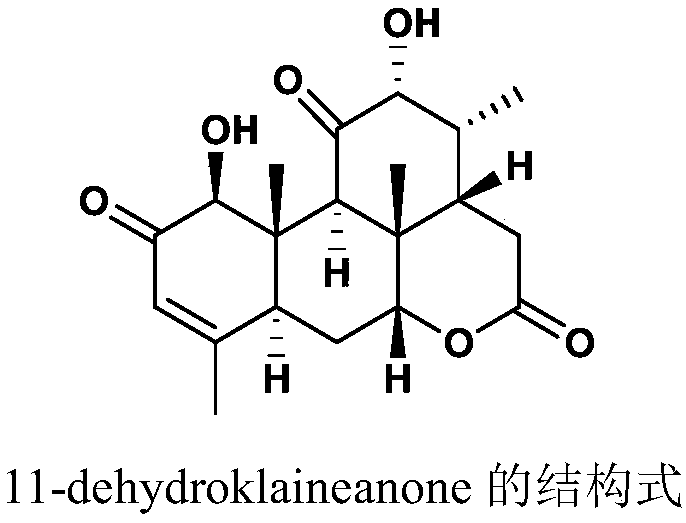Application of 11-dehydroklaineanone in antifeedant activity of insects and inhibition of growth and development of insects
An insect and active technology, applied in the fields of application, plant growth regulators, insecticides, etc., can solve the problem of insect antifeedants, etc., and achieve the effect of environmental protection and high antifeedant activity
- Summary
- Abstract
- Description
- Claims
- Application Information
AI Technical Summary
Problems solved by technology
Method used
Image
Examples
Embodiment 111
[0023] Example 111-dehydroklaineanone can be sucked into the root through the root of S. chinensis, and transported upward to the leaves, so that insects refuse to eat the leaves of Chinese cabbage
[0024] Method: Dissolve 11-dehydroklaineanone in DMSO to make a mother solution of 10000μg / mL, and then use 0.5mMCaCl 2 Dilute the stock solution with aqueous solution to 100 μg / mL culture solution. Put the untreated Shanghai green seedlings (6-leaf stage) cultivated in advance in 0.5mM CaCl 2 After pre-cultivation in aqueous solution for 2 hours, transfer it into the 100 μg / mL 11-dehydroklaineanone culture solution prepared above. After 24 hours of cultivation, take 0.7 g of the top leaves of Shanghai green, mash it and dissolve it in 2 mL of methanol, and use liquid chromatography - Mass spectrometry can detect that the extract contains 11-dehydroklaineanone. According to the calculation, the content of 11-dehydroklaineanone in the top leaves (fresh leaves) of Haiqing reached ...
Embodiment 2
[0030] Example 2: 11-dehydroklaineanone inhibits cell proliferation of diamondback moth and Spodoptera litura
[0031] To explore whether 11-dehydroklaineanone has an inhibitory effect on the proliferation of diamondback moth embryo cells and Spodoptera litura ovary cells, the CCK-8 method was used to detect the inhibition rate of cell proliferation, and the results are shown in Table 1:
[0032] Table 1 Inhibition rate of 11-dehydroklaineanone on insect cell proliferation
[0033]
[0034] Experimental conclusion: It can be seen from Table 1 that 11-dehydroklaineanone has a significant inhibitory effect on the proliferation of insect cells, which is positively correlated with the concentration of 11-dehydroklaineanone. The inhibition rate of different concentrations of 11-dehydroklaineanone on Plutella xylostella ovary cells was greater than 35%; 11-dehydroklaineanone also had a strong inhibitory effect on Plutella xylostella embryo cells; the sensitivity of 11-dehydroklai...
Embodiment 3
[0035] Example 3: Antifeedant activity of 11-dehydroklaineanone to insects
[0036] Method: Dissolve 11-dehydroklaineanone in acetone to make a mother solution of 2000 μg / mL, then dilute the mother solution with acetone into 5, 10 and 20 μg / mL solutions and spread evenly on a circular cabbage leaf dish with a diameter of 1.5 cm On the surface, the amount of drug applied to each leaf dish was 20 μL. After the acetone on the surface of the leaf dish was naturally dried, the 3rd instar larvae of the diamondback moth Plutellaxylostella (Linnaeus) were inserted, and each concentration treatment was repeated 3 times. %, the temperature is 25 DEG C ~ 28 DEG C in an environment for 24 hours, count the feeding area, calculate the feeding rate and refusal rate, the calculation formula is shown in Example 1.
[0037] Cassava leaves were used to test the antifeedant activity of 11-dehydroklaineanone against 1st instar larvae of Spodoptera litura (Fabricius); Amaranth leaves were used to t...
PUM
 Login to View More
Login to View More Abstract
Description
Claims
Application Information
 Login to View More
Login to View More - R&D
- Intellectual Property
- Life Sciences
- Materials
- Tech Scout
- Unparalleled Data Quality
- Higher Quality Content
- 60% Fewer Hallucinations
Browse by: Latest US Patents, China's latest patents, Technical Efficacy Thesaurus, Application Domain, Technology Topic, Popular Technical Reports.
© 2025 PatSnap. All rights reserved.Legal|Privacy policy|Modern Slavery Act Transparency Statement|Sitemap|About US| Contact US: help@patsnap.com



